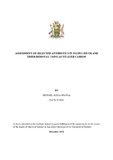| dc.description.abstract | Occurrence of antibiotics in aquatic environment has become of concern in the recent past due to
development of antibiotic resistance among microorganisms. In addition, most Pharmaceuticals
and Personal Care Products (PPCPs) are known to disrupt reproduction and hormone function of
some aquatic organisms. The objective of this study was to determine the existence and distribution
of three active ingredients of Amoxicillin (AMX), Sulfamethoxazole (SMX) and Trimethoprim
(TMP) antibiotics in water from Ngong River Kenya, and their removal from water using activated
carbon. Water samples were collected from seven sites along Ngong River profile constituting the
up-, mid- and down-stream. Liquid/Liquid Extraction (LLE) method was used to extract antibiotics
from the water samples. The extracts were analyzed for the presence of AMX, SMX and TMP
using High Performance Liquid Chromatography (HPLC) coupled with UV/VIS detector. The
levels of AMX, SMX and TMP were between <0.20 to 9.07±7.78 μg/l, 10.69±1.33 μg/L and
1.91±0.02 μg/L, respectively. Lower concentrations of antibiotics were detected during the wet
season due to dilution by rain water. The detection limits for AMX, SMX and TMP were 0.20,
2.20 and 1.30 μg/l, respectively. The trend in the sum concentration (μg/L) was SMX>TMP>AMX
in the wet season and SMX>AMX>TMP in the dry season. The presence of SMX in wastewater
effluent from Ruai outlet showed that the treatment plant was ineffective at completely removing
antibiotic contaminants from the wastewater. Adsorption of AMX, SMX and TMP was notably
greater on Powdered Activated Carbon (PAC) than on Granulated Activated Carbon (GAC),
suggesting that PAC was a better adsorbent for the antibiotics in both distilled and surface water.
Adsorption data fitted better on Freundlich isotherm than Langmuir isotherm, suggesting a
physical process. The results revealed contamination of Ngong River water by antibiotic residues,
which has a potential impact on antibiotic resistance. In addition, the removal of antibiotic residues
from water could be improved by introducing activated carbon filters in the water treatment train.
However, further studies should be conducted using water from the wastewater treatment plant to
understand the effect of organic load on adsorption processes using PAC and GAC. | en_US |



